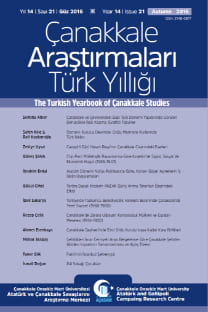Keltlerin Anadolu'ya göçü: Göç nedenleri, yolları ve ilk on yıl
Türkiyenin eskiçağ tarihi ilki İ.Ö. 3. binyılın son üç yüz yüzyılı içinde, ikin- cisi İ.Ö. 2. binyılın son iki yüz yılına girildiğinde olmak üzere yaklaşık biner yıl arayla iki büyük kitlesel göçe tanıklık etti. İkincisinden takriben bin yıl sonra bir kitlesel göç de bugünkü Balkan devletlerinin bulunduğu coğrafyaya sirayet etti. Sonuncusu bildirimizin konusunu oluşturmaktadır ve bu göçe ilişkin bilgiler, eski Yunan ve Latin dilinde yazılmış ve bize kadar ulaşmış bulunan antik edebi kaynaklarda ve yazıtlarda mevcuttur. Göçmenlerin etnik kimlikleri konusun- da bir tartışma söz konusu değildir. Onlar, eski Yunanlıların Keltler (Keltoi), Romalıların Galler (Galli) dedikleri Kuzey Avrupanın adı bilinen ilk yerli hal- kıydılar. Hint-Avrupalıydılar ve Keltçe konuşuyorlardı. Antik edebi kaynak- larda özellikle onların Anadoluya geçen grubundan Galatlar diye söz edildi. Anadoluda yerleşmiş oldukları yukarı Kızıl Irmak dolaylarını da içine alan Kuzey Phrygiaya ise Galatia, yani Galatların ülkesi denildi. Ancak onların ne- den, nasıl ve hangi yoldan Anadoluya geçmiş oldukları ve Anadoluya geçtikten sonraki eylemleri konusunda Antik edebi kaynaklar yetersizdir veya bu kay- naklar çelişkili bilgiler aktarırlar. Bu bildiride amacımız, Kelt/Galat göçünün nedenini ve nasıl geliştiğini, göç yollarını, göçten sonraki eylemlerini antik edebi kaynakların aktardığı bilgileri, epigrafik ve numismatik belgeler ile günümüz tarihçilerinin araştırmalarını dikkate alarak tanımlayıp anlatmaktır.
TheMigration of Celts to Anatolia. Reasons and Roads of Migration and the First Ten Years
The ancient history of Turkey testified massive migrations, with intervals of a thousand years each. The first of these migrations occurred in last centu- ries of the Third millennium BC and the second migration towards the last two centuries of the second millennium BC. After about a thousand years from the latter, another massive migration, which composed the topic of my paper, spread to the areas of modern Balkan States. There are accounts relating to this migra- tion in ancient literary sources written in Greek and Latin languages. A discus- sion referring to the ethnicities of these immigrants, will not be made because they were the first indigenous people and they are mentioned as Celts (Keltoi) and Gauls (Galli) by ancient Greeks and Romans respectively. A groups of them that passed to Anatolia, were especially mentioned as the Galatians in ancient literary sources. They settled northern Phrygia including the upper region of Halys (modern Kızılırmak), and later this area was named Galatia after the Galatians. Nevertheless accounts in ancient literary sources are inadequate or inconsistent with their deeds after passing to Anatolia, where they came from? Why and how they did? Which paths they used? The aim in this paper is to research the reason, developments and paths of the Celtic/Galatian migration, and their deeds after the migration by using literary sources and epigraphic, numismatic and modern studies.
___
- Appianos, Romaika (Appians Roman History, translated by H. White), Vols. I-IV. (Ed. E. H. Warmington), Loeb, London 1972. (Syriaka, 2. Ciltte XI. Kitap).
- Arrianos, Anabasis Alexandrou (Arrian, Anabasis of Alexander, translated by E.I. Robson), Vols. I-II. Loeb, London 1967.
- Cunliffe, B., The Ancient Celts, London 1999.
- Diodoros, Bibliothekes Historikes (Diodoros of Sicily, translated by C.H. Oldfather), Vols. I-XII (ed. E.H. Warmington), Loeb. London 1967.
- Erzen, A. İlkçağda Ankara, Ankara 1946.
- Head, B.V., Historia Numorum, A manual of Greek Numismatics, London 1911.
- Iustinus, Historiarum Philippicarum et Totius Mundi Originum, Amstelodami 1659.
- Kaya, M. Ali, Anadoluda Galatlar ve Galatya Tarihi, Konya 2011.
- Livius, Ab Urbe Condita (Livy, From the foudation of the City, translated by B.O. Forster), vols. I-IV, (ed. E.H. Warmington), Loeb. London 1967.
- Magie, D., Roman Rule in Asia Minor to the End of Third Century after Christ I-II, Princeton 1950.
- Memnon, Peri Herakleia (Memnon, translated by C. Müller), Die Fragmente der griechischen Historiker, vol. III, Parisiis 1853.
- Mitchell, S., Anatolia. Land, Man and Gods in Asia Minor (vol. I), Oxford 1993.
- Navarro, M. de, Coming of the Celts, The Cambridge Ancient History (ed. J.B. Bury & S.A. Cook), Vol. VIII, Cambridge 1978, s. 41-74.
- Orientis Graeci Inscriptiones Selectae (Ed. W. Dittenberger), Leipzig 1903.
- Pausanias, Helledos Periegeseos (Description of Greece, translated by W.H.S. Jones), Vols. I-IV. (Ed. E. Capps, T.E. Page, W.H.D. Rouse), Loeb. London 1968.
- Plinius, Naturalis Historia ( Natural History, translated by H. Rackham), vols. I-X (ed. E. H. Warmington), Loeb, London 1969.
- Polybios, Histories (The Histories, translated by W. R. Paton), vols. I-VI. Loeb, London 1998.
- Rankin, H.D., Celts and Classical World, London 1998.
- Stahelin, E. Geschichte der kleinasiatischen Galater, Leipzig 1973.
- Strabon, Georaphika (The Geoggraphy of Strabo, translated by H.C. Jones), vols. I-VIII (ed. T.E. Page), Loeb, London 1960.
- Strobel, K., Die Galater im hellenischen Kleinasien Historische aspekte einer keltischen Sta- atenbildung, Hellenischen Studien Gedenkschrift für Hermann Bengtson. München 1991, s. 101-134.
- Tarn, W.M., The New Hellenistic Kingdom, The Cambridge Ancient History (ed. J.B. Bury & S.A. Cook), Vol. VIII, Cambridge 1978, s. 75-108.
- Welles, C.B., Royal Correspondence in the Hellenistic Period, A Study in Greek Epigraphy, New Haven 1934.
- ISSN: 2148-0877
- Yayın Aralığı: Yılda 2 Sayı
- Başlangıç: 2003
- Yayıncı: Murat Karataş
Sayıdaki Diğer Makaleler
Sözlü Tarih Anlatılarında Çanakkale Merkeze Giritaten Göçler: aGiritli, Başı Bitlia¦a
Keltlerin Anadolu'ya göçü: Göç nedenleri, yolları ve ilk on yıl
Sözlü Tarih Anlatılarında Çanakkale Merkeze Girit'ten Göçler: Giritli, Başı Bitli...'
Eski Çağada Anadoluanun Siyasi ve Demografik Yapısını Değiştiren Kitlesel Göçler
Pers Hakimiyetinde Troas Bölgesine Yapılan Göçler
Reyhan Körpe & Mehmet Fatih YAVUZ
Yeni Edirne Gazetesi'ne Göre Bulgaristan'dan Türkiye'ye Göçler 1950-1951
Çanakkale Merkeze ve İlçelerine Yerleştirilen Giritli Mübâdil Göçmenler
Keltlerin Anadolu’ya Göçü: Göç Nedenleri, Yolları ve İlk On Yıl
